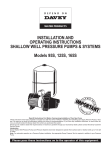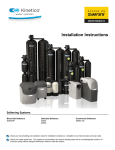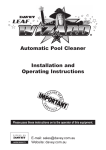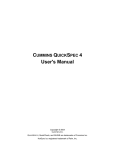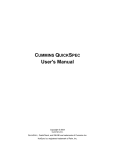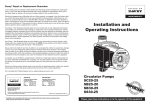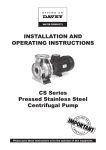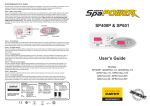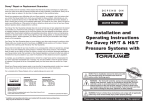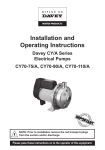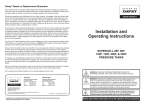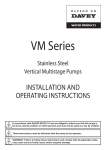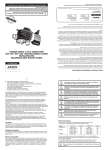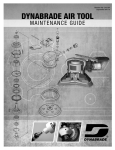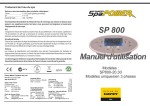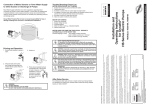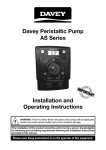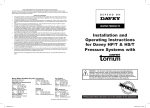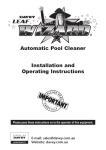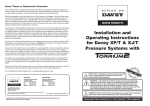Download INSTALLATION & OPERATING INSTRUCTIONS FOR ELECTRIC
Transcript
7. Delivery Piping Friction in the delivery increases the head on the pump and so reduces capacity and pressure available at the delivery point. To minimise performance losses we recommend the use of larger diameter pipe. For more detailed advice concerning deliver heads and delivery piping, please consult your local Davey Dealer. Ensure sealing gasket is correctly fitted between pump and companion flange connections. Do NOT screw connections too far into the pump’s suction and delivery companion flanges. Do not exceed tightening force of 60ft lb (8.2kgm). i.e. 60lb force at the end of 1 foot wrench (25Kg at 30 cm). Note: Suction leaks are THE biggest cause of operating difficulties and are hard to detect because the problem is air leaking INTO the pipe and there may be no external sign of the leak. It is essential that all suction connections are completely sealed, using thread sealing tape. To reduce pipe friction and maximize flow we recommend the use of pipe with equal or larger diameter than the inlet on your pump. For detailed recommendations regarding long suctions, please contact your Davey Dealer. Do not allow the suction pipe to lay in exposed sunlight if possible as the water inside will heat up during periods when the pump is not operating. This will reduce the suction capacity of the pump during initial starting. Suction piping should be laid so there is a constant rise from the water source to the pump. Any high spots will cause air pockets to form and reduce the efficiency of the system. In accordance with AS 3350.2.41 we are obliged to inform you that this pump is not to be used by children or infirm persons and must not be used as a toy by children. POWER CONNECTIONS AND WIRING MUST BE CARRIED OUT BY AN AUTHORISED ELECTRICIAN. When the unit is connected and operating the phase balance should be checked. This should be within 5% variation. “Rolling” the leads may help to improve a small unbalance, but major phase unbalance will usually be attributable to an input power unbalance. This must be addressed before the pump is used. BEFORE FINALISING WIRING CONNECTIONS, CHECK THAT MOTOR ROTATES IN DIRECTION OF ARROW (CLOCKWISE WHEN SHAFT IS VIEWED FROM WIRING CONNECTION END). TO ALTER ROTATION, CHANGE ANY TWO POWER LEADS AT MOTOR TERMINALS. 6. Suction Piping Suction lift is made up of the actual vertical height from the water level below the pump to the pump inlet port, plus the friction in the suction piping and fittings. For best performance easiest priming, situate the pump as close to the water source as possible. Important Note: - Three Phase Models Only Important: For installations which may allow water to run back through the pump after switching off (e.g. overhead tank filling), a check valve (non-return valve) must be installed at the pump outlet to prevent water cascading back though pump. Installations having a positive suction pressure (flooded suction) require a gate valve to be installed in the suction piping. This is to allow for future servicing needs. Three phase models are designed for connection to a nominal 415V (±5%) power supply, but must be wired with a contactor with ‘quicktrip” overloads set to suit the motor. Davey recommend the use of overloads which also have the ability to detect “single phasing” or “dropped phase” conditions in the power supply. Three Phase 5. Foot Valve – Check Valve All installations involving a suction lift should have a good quality foot valve at the end of the suction pipe to retain water in the suction pipe and pump body. Always ensure that the earth conductor on the motor is connected to a good earth. Never run this pump without discharge flow for more than a few minutes, as the water will heat and cause damage to the pump or pipe lines not covered by guarantee. 4. Delivery Head Care should be taken to ensure that the combined suction and delivery head (including pipe friction) of the installed pump does not exceed the total head shown in the pump performance tables against the required capacity. 3. Note: 1. 2. Optimum performance will be achieved on suction heads (including friction) up to 4.5m (15 feet). The maximum practical suction head (including friction) for this type of pump is 7.5m (25 feet). 3. Suction Lift For best performance and easiest priming, site the pump as close to the water source as possible. Ensure motor is connected to power supply specified on nameplate. Avoid long extension leads as they can cause substantial voltage drop and operating problems. Although the electric motor is specifically engineered to perform on a range of power supply voltages, malfunctions or failure caused by adverse voltage supply conditions are not covered under guarantee. The electrical connections and checks must be made by a qualified electrician and comply with applicable local standards. 8. Power Connection -2- -3- Davey® Repair or Replacement Guarantee In the unlikely event in Australia or New Zealand that this Davey product develops any malfunction within one year of the date of original purchase due to faulty materials or manufacture, Davey will at our option repair or replace it for you free of charge, subject to the conditions below. Should you experience any difficulties with your Davey product, we suggest in the first instance that you contact the Davey Dealer from which you purchased the Davey product. Alternatively you can phone our Customer Service line on 1300 367 866 in Australia, or 0800 654 333 in New Zealand, or send a written letter to Davey at the address listed below. On receipt of your claim, Davey will seek to resolve your difficulties or, if the product is faulty or defective, advise you on how to have your Davey product repaired, obtain a replacement or a refund. Your Davey One Year Guarantee naturally does not cover normal wear or tear, replacement of product consumables (i.e. mechanical seals, bearings or capacitors), loss or damage resulting from misuse or negligent handling, improper use for which the product was not designed or advertised, failure to properly follow the provided installation and operating instructions, failure to carry out maintenance, corrosive or abrasive water or other liquid, lightning or high voltage spikes, or unauthorized persons attempting repairs. Where applicable, your Davey product must only be connected to the voltage shown on the nameplate. INSTALLATION & OPERATING INSTRUCTIONS FOR ELECTRIC CENTRIFUGAL PUMPS MODELS CD40-40, CD40-55, CD40-75 Your Davey One Year Guarantee does not cover freight or any other costs incurred in making a claim. Please retain your receipt as proof of purchase; you MUST provide evidence of the date of original purchase when claiming under the Davey One Year Guarantee. Davey shall not be liable for any loss of profits or any consequential, indirect or special loss, damage or injury of any kind whatsoever arising directly or indirectly from Davey products. This limitation does not apply to any liability of Davey for failure to comply with a consumer guarantee applicable to your Davey product under the Australian or New Zealand legislation and does not affect any rights or remedies that may be available to you under the Australian or New Zealand Consumer Legislation. In Australia, you are entitled to a replacement or refund for a major failure and for compensation for any other reasonably foreseeable loss or damage. You are also entitled to have the goods repaired or replaced if the goods fail to be of acceptable quality and the failure does not amount to a major failure. Should your Davey product require repair or service after the guarantee period; contact your nearest Davey Dealer or phone the Davey Support Centre on the number listed below. For a complete list of Davey Dealers visit our website (davey.com.au) or call: Please pass these instructions on to the operator of this equipment. WARNING : The pump and associated pipework operate under pressure. Under no circumstances should the pump or associated pipework be disassembled unless the internal pressure of the unit has been relieved. Failure to observe this warning will expose persons to the possibility of personal injury and may also result in damage to the pump, pipework or other property. WARNING: Failure to follow these instructions and comply with all applicable codes may cause serious bodily injury and/or property damage. Davey Water Products Pty Ltd Member of the GUD Group ABN 18 066 327 517 AUSTRALIA NEW ZEALAND Davey Support Centre 6 Lakeview Drive, Scoresby, Australia 3179 Ph: 1300 367 866 Fax: 1300 369 119 Website:davey.com.au Davey Support Centre 7 Rockridge Avenue, Penrose, Auckland 1061 Ph: 0800 654 333 Fax: 09 527 7654 Website:daveynz.co.nz ® Davey & Dynajet are registered trade marks of Davey Water Products Pty Ltd. © Davey Water Products Pty Ltd 2014. * Installation and operating instructions are included with the product when purchased new. They may also be found on our website. P/N 48719-3 Read all Instructions Before Installing Your New Davey Pump 1.Introduction These instructions have been prepared to acquaint you with the correct method of installing and operating your Davey pump. We urge you to study this publication carefully and follow its recommendations. In the event of installation difficulties or the need for further advice you should contact the Davey Dealer from whom you purchased the unit. 2. Housing Your Davey Pump As the pump is an electrical apparatus it must be protected from the weather, at the same time adequate ventilation must be provided for the motor. Do not enclose the pump in such a manner that a “hotbox” condition is created. Ventilation should be provided near the top of any enclosure to prevent a “buildup” of condensation. The maximum ambient air temperature must not exceed 40oC. Your pump should be mounted on a firm base enough to prevent any surface water from flooding the unit. Positioning of the unit should allow the nameplate to be easily read and provide adequate access for service purpose. Failure to adequately house your pump, as outlined above, will render your guarantee void. -49. Priming and Operation The pump body and suction line should be filled by pouring water into the priming plug hole adjacent to the outlet. Screw on the priming plug, close the discharge valve two thirds and switch pump on. Gradually open the discharge valve as the pipeline fills. In high suction lift conditions, the pump may make a noise similar to it pumping sand or gravel; this will usually be cavitation occurring. Reduce flow until the cavitation noise stops. Once the discharge pipeline fills you can open the valve. If the cavitation noise returns, close the discharge valve slightly until it stops. In the case of installation where there is a positive suction pressure (flooded suction) remove the pump’s priming plug and slowly open the gate valve in the suction piping to allow water to enter the pump from the suction line until all air is expelled. Replace the priming plug and fully open the gate valve in the suction line and switch the pump on. Prime should be established almost immediately, however, it may be necessary to re-prime several times on some installations before fully established optimum pump performance. - - Do not run pump dry or allow to run continuously in a loss of prime condition. If this pump is allowed to pump water containing sand or other abrasive material, the effective life of the pump will be shortened. If pump runs but will not pump water, check for the following: 1. Suction line and pump body not filled with water. 2. Leaking foot valve. 3. Air leaks in suction lines. 4. Air trapped in suction line (even on flooded suction) possibly when there is an uneven rise in the piping from water to pump (eliminate “humps and hollows”). 10. Trouble Shooting WARNING: When servicing or attending pump, always ensure power is switched off and lead unplugged. Electrical connections should be serviced only by qualified persons. Care should also be taken when servicing or disassembling pump to avoid possible injury from hot pressurised water. Unplug pump, relieve pressure by opening a tap on the discharge side of the pump and allow any hot water in the pump to cool before attempting to dismantle. A. IF MOTOR RUNS, BUT PUMP DOES NOT DELIVER WATER, OR FLOW RATE IS REDUCED, ONE OR MORE OF THE FOLLOWING MAY BE THE CAUSE: 1. 2. 3. Pump not primed: Refer instructions on Priming and Operation. Leaks in Piping or from seal: Check suction piping and repair any leaks. A leaking seal may also prevent pump operating. Low water level: Foot valve (entry) out of water or suction lift too great because of reduced water level. Extend piping and/or re-site pump closer to the water. Total pump delivery head too great: Calculate total pump head and check against pump’s published performance. Reduce head, use larger pipe or use higher head pump. Piping or pump blocked: Check both piping and pump internals and unblock as required. Special attention should be paid to inspecting the internals of the impeller for blockages. Defective valves: Check that foot valve can open and valves in piping will allow water to pass (are they installed in the correct direction?) Repair or replace any defective valves. Incorrect direction of rotation – 3 phase models: Check that impeller rotates in an anti-clockwise direction when viewed from suction end. 4. 5. 6. 7. TO CHANGE DIRECTION OF ROTATION FOR 3 PHASE MODELS, SWAP ANY TWO POWER LEADS AT MOTOR – REFER “POWER CONNECTION INSTRUCTIONS”. -5B. IF MOTOR FAILS TO RUN, ONE OR MORE OF THE FOLLOWING MAY BE THE CAUSE: 1. Pump not connected: Check power point to ensure power is available. Check fuses and main power supply switch. The electrical connections and checks must be made by a qualified electrician and comply with applicable local standards. 2. 3. 4. 5. Voltage too low: Eliminate long leads or replace with heavier, higher capacity leads. Overload tripped: Determine the cause of overload tripping and rectify. Motor not free to turn: Remove end cap, and using a screwdriver in slot at end of shaft, check that motor shaft is free to turn. If not free, remove pump body and rectify cause of binding. Internal motor fault: Have unit checked by your local Davey Dealer. 11. Spare Parts When ordering spare parts, it is essential to give both pump model and motor type numbers from nameplate as well as the full description on part required.


